
Reading Time: 10 minutes
Can a pothole damage your car? Most definitely, and they do. ThudCrunch! Your steering wheel violently jerks out of your hand, and your brand new Firestone disappears down a mini Grand Canyon. With potholes there may be more at stake than just a bent rim or blown tire.
Research from the AAA shows potholes cause an estimated $3 billion worth of blown tires, busted axles, and other damages each year.
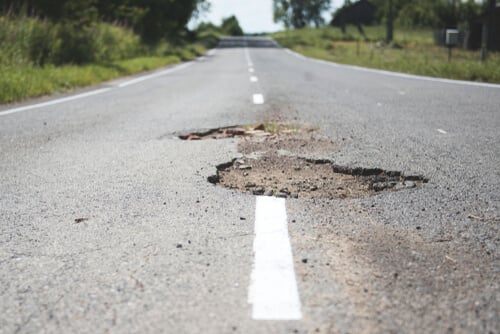
When your car needs to be in another state, ship it with an auto shipping company like Nationwide Auto Transport. Read Car Shipping Made Easy, if you want to know about the advantages of shipping your vehicle. Read this post if you want to learn about pothole hazards, and how to try and prevent becoming another holey statistic.
Discover key insights on choosing the right vehicle shipping service with Nationwide Auto Transportation’s informative blog post. Dive into “Vehicle Shipping Company Considerations” for expert advice on seamless and reliable auto transport solutions. Read more here: Nationwide Auto Transportation Blog.
Your Car and the Pothole Damage Plague
We know that pothole damage is real, but sooner or later, most of us get to experience that sinking feeling when you go too fast through a pothole that looks like a puddle, but sounded like you drove into a quarry.
Slalom game on point, but eventually damage gets you. Realize later car doesn’t handle as well.
The severity and type of damage caused to your vehicle by potholes is directly related to two factors:
- The speed at which you hit the pothole;
- The depth of the offending hole?
What happens when you hit a pothole? Let’s uncover the damage potholes cause and what you should do when you go through one.

Pothole Damage: How Bad can it Really Be?
Check your tires and rims for signs of pothole damage. If you notice a bulge or crack on your tires, it’s time to get a new set. Also examine the rims closely for scuffs or dents. Examine your car’s steering and suspension, brakes, and bodywork for pothole damage. Check tire pressure monthly and look for signs of damage on tires and rims. If you notice a bulge or crack on your tires, replace them. Check rims for scuffs or dents.
Tired Tires
In pothole situations, your car’s tires are most at risk. Typical pothole tire damage includes sidewall bulges, tread separations, and punctures. Your tires might also experience uneven wear if their alignment is thrown out of alignment by the pothole, or your rims might be damaged by a deep or large pothole.
Why are Potholes so Damaging?
The sudden impact of a pothole can launch a car’s axle or chassis upwards. Resulting in the axle becoming misaligned and the suspension system being jarred. We’re learning how potholes can damage cars and their investments. What causes this? Let’s look under the car: a pothole can launch the axle or chassis upward, resulting in misalignment and jarring of the suspension system.
- When a tyre hits a pothole, the impact separates the airtight liner from the sidewall of the tyre, allowing air to seep into the tyre, which forms a bubble in the sidewall that is practically a ticking time bomb.
- When you strike the hard edge of a pothole, the tyre is compressed against the wheel, causing the rubber to slice, causing tread separation.
- Modern cars typically have aluminum rims, which can easily be dented by potholes.
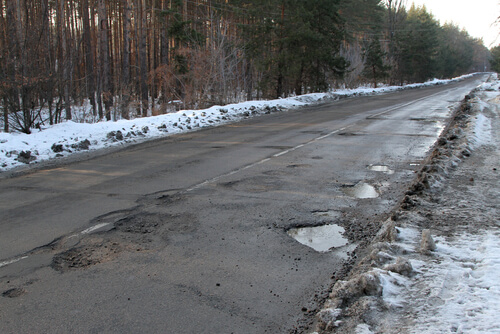
Are Your Tires Damaged? What can You do About it?
Even though you have the driving skills of a rally driver that grew up on backroads of Wisconsin, potholes have the knack to stay invisible until it is too late! Kathunk! When that happens it is best to give your car, wheels and tires a thorough once over:
- Keep an eye on your tyres if you notice uneven wear. It is strongly recommended to get your tyres changed as soon as possible if you notice any other damage to them.
- Replace your dented rims as soon as possible. Dented rims lead to poor air seals between rim and tyre. This can cause air leaks and flat tyres.
In a perfect world roads would be smooth and tires never get punctures. However, as we have been reminded by the pandemic, we don’t live in a perfect world! Punctures and wheel damage is part of reality – but can we minimize the damage?
How can you prevent pothole damage to your tires?
It is best to avoid potholes completely, but you can help prevent damage by making sure your tyres are correctly inflated. “And how do you avoid potholes completely?”, I hear you ask. If your destination is anything further than around 900 miles, it could be worth thinking of shipping your car.
This not only negates any pothole damage to your car, it saves you adding miles on the odometer, and what is more – it does not require you to take out a second mortgage. To find out about our 20% discount for first time customers get a free, no obligation quote from National Auto Transportation.

Moving further along, how about we do a little burnout, or maybe I’ll just stick to writing about the wheels.
The Wheel Story
How we love the inventor of the wheel! Without that person (political correctness, although we know it was a man), traveling by car would have been an unknown experience. But those round rolling rubber rotating hoops, that are essential for your safety, are under constant threat from pothole damage.
- Potholes may cause your wheel to bend, chip, or crack, preventing it from forming an airtight seal with the tyre. Driving with a bent wheel will also make the car jerky and most certainly not the smooth ride you are used to. It is important to note that chips on wheels can be difficult to spot, since they can be very small or located in a spoke or buried under brake dust and road grit.
- Wheel alignment is another potential problem. If you hit a pothole hard, it can knock your wheels out of alignment when your steering mechanism feels the impact. The damage might not be noticed until the car pulls to one side, or the steering is less responsive than before.
Do you know what to do if your wheels show signs of damage?
The importance of good tires and undamaged wheels and steering system, cannot be accentuated enough.
- A cracked or chipped wheel can cause major problems, so it’s best to completely replace it.
- In some cases, bent wheels can be repaired. I suggest that, even if all feels good, spend the $100 on getting the alignment done anyway.
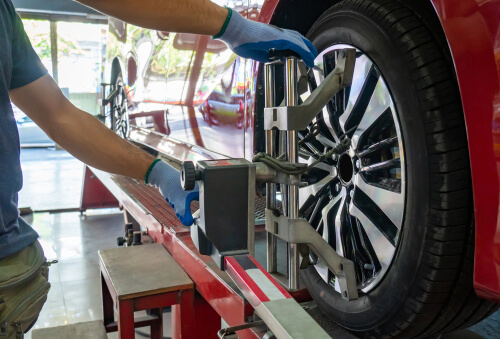
How are you doing there? Hope you are not too tired? (Laugh)… Let me not keep you too much in suspension and steer right along to our next body parts that can suffer from pothole damage.
Suspension and steering
An analysis of data from the Department of Transportation found that the percentage of U.S. highways in poor condition grew by 25% in 9 years. It also revealed that about 10% of U.S. highways were in poor shape based on a roughness score.
About 31% were considered acceptable, and 59% were considered good. Now do you understand how important your car’s steering and suspension is? It magically smoothes away bumps and lumps in the road… until that sudden impact of rubber against asphalt, knocks all kind of problems into your suspension:
- The car is pulling to one side
- Feeling loose when handling
- Tire wear that is uneven
- Vibrations and sounds that are unusual (and not those from your wifey’s Chanel purse)
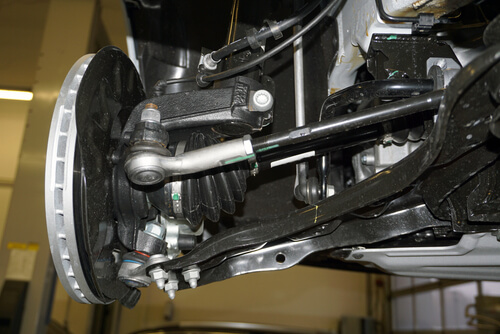
How Does a Pothole Damage Steering and Suspension?
Science tells us about force that equals speed and inertia is somehow thrown in the mix. When you hit a pothole, the initial force damages the steering and suspension components when it travels through your tires. Included here are the shock absorbers, springs, tie rod ends, control arms, and other components. It is to be noted that the repeated jolts caused by potholes can accelerate wear on your suspension and steering.
While we are talking about suspensions and steering and things that can be modified – Lowrider lovers should find this post uplifting: Cheapest State for Vehicle Modifications: It is the One Where you Find the Best Deal.
Are You Aware of Any Damage to Your Steering and Suspension?
Replacement of worn or damaged parts is the most common solution to steering and suspension problems. Your safety is at risk if your steering and suspension systems are damaged. Get this checked out immediately.

Exhaust, undercarriage, and body
Low-rider cars handle better, but they are also more likely to be damaged by potholes. A pothole can scratch the bumpers or side skirts of a vehicle. In addition to scrapes along your undercarriage that cause rust, your exhaust pipes, muffler or catalytic converter may also suffer damage.
Damage to your exhaust pipes will result in loud noises and power loss. The exhaust could also release harmful pollution, including fumes that could leak into your cabin, and could be harmful to your health.
Do you know what to do if your body, undercarriage, or exhaust is damaged?
Carbon footprint is one of the buzzwords at the moment, and we are all trying to do our bit to lessen our impact on our environment – and if you haven’t thought about it, please do – a little is better than nothing. Exhaust problems should be taken seriously and fixed as soon as possible, indeed this is not just for your health, but everyone else’s as well.
Examen the underside of your car for damage. If you find any, fix them on the spot, cosmetic damage to side skirts and bumpers can be repaired in your own time and preference.
Let’s take a quick detour and have a glance at where you will find the worst roads in America.
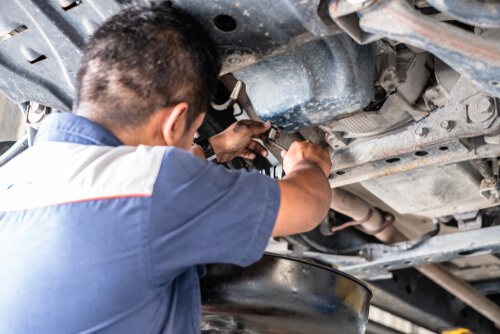
What are the Worst Places for Pothole Damage
I mentioned before that a large percentage of roads in the US are in need of attention, and it is not on the cards that this is going to improve soon, or drastically. So, do you stay in one of the states, or cities with the worst roads in the country?
43% of U.S. roads are in poor or mediocre condition, costing drivers more than $130 billion a year in repair and maintenance.
The question is: What city’s roads have the most prickly potholes, b, b, bloody bumps, and “Hell not Again! hazards? Below are 3 cities with difficult road surfaces:
Pothole Damage Capitals
- Boston – This founding city finds itself with a raggedy road system. INRIX claims that Boston residents spent more time in traffic than any other city – in 2019 a driver spent an average of four working weeks in traffic – that is crazy in any car. And what is the reason for this gridlocked waste of time? A combination of poor road conditions and traffic jams. MoneyGeek cites Massachusetts as the sixth worst state for road conditions.
- Detroit – As freezing roads thaw and create potholes in Detroit, motorists face a number of challenges. FHA data shows that nearly half of Detroit’s streets are in poor condition. The American Society of Civil Engineers awards Michigan’s roads a D-minus and claims that 39% of the state’s roads are in poor condition, or more than 46,000 miles. MoneyGeek ranks Michigan’s roads ninth worst in the country.
- Portland – Driving in the Rose City isn’t always rosy as a majority of Portland’s roads are in poor or fair condition, according to a city report. Portland residents spend more than $1,200 a year as a result of travel time delays and fuel consumption associated with gridlock in the city, according to a study from Texas A&M University. In fact, Portland has the 11th highest average cost per driver in the United States, making it one of the worst cities for driving in the country.
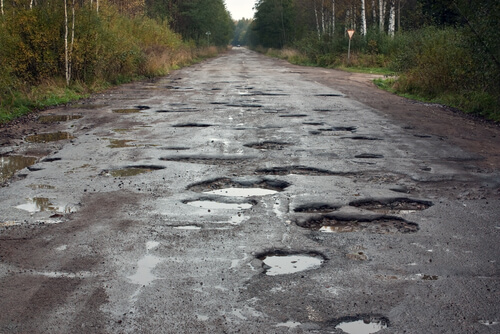
Does my auto insurance cover damage caused by potholes?
Pothole damage is usually covered under your auto insurance policy. However an optional collision insurance policy covers damage to a car caused by a collision with another vehicle, a lamp post, or a pothole. Nevertheless, it does not cover damage caused by bad road conditions to a car or its tires.
Insurance companies usually sell collision coverage with deductibles, the higher the deductible, the cheaper the premium. You will receive reimbursement for the repair costs of your car, minus your deductible.
Collision insurance differs from comprehensive insurance, which is a separate coverage option. Drivers with comprehensive coverage are covered for theft, vandalism, flooding, and damage caused by falling objects, including trees.
The driver of a car that hits another car, or a pedestrian, due to a pothole is also covered by liability insurance. This is a legal requirement in every state except New Hampshire. Liability coverage protects you against injuries caused by you, the policyholder, or the designated driver.
You can also file a claim with your insurance company, but some jurisdictions, like Chicago and New York, may pay for pothole damage. When a driver encounters a pothole, they should determine what authority maintains the road and find out about compensation. Once they have information, they need to make a claim.

As we have shown, the most common pothole damage is to wheels and tires and in certain instances, they can also damage steering and suspension systems. In cases where the pothole damage to your vehicle falls below the amount of your deductible, typically $500 or $1,000, it may not be feasible to file a claim.
Have you had Your Fill of Pothole Damage?
Due to the age and wear and tear on our public roads, elected officials must work together with other agencies to ensure the integrity of our roads. In a country where mobility and vehicles are essential for economic growth, maintaining the integrity of public roads is not only essential for public health, but also for the stability of the economy.
Nationwide Auto Transportation have highly professional drivers, who know their routes like the back of their hand, to transport your vehicle safely and without any chance of it sustaining pothole damage on the journey.
Book your pick-up date and receive a free quote from us today. We only need your basic vehicle information as well as your location, destination, and preferred shipping method. We will give you the best possible quote free of charge.



